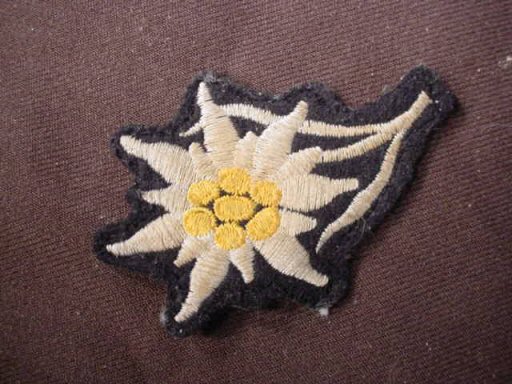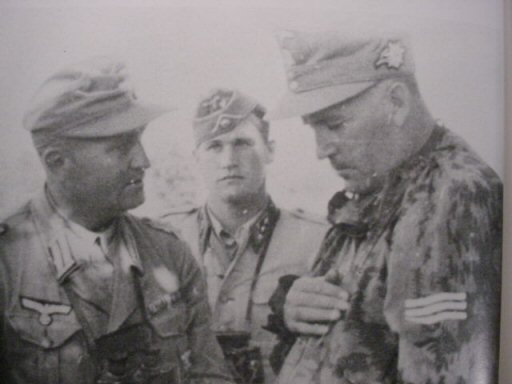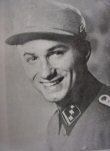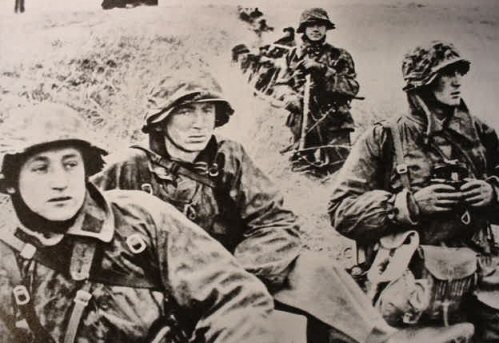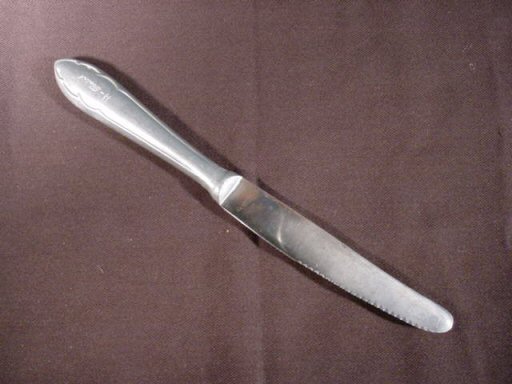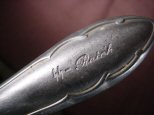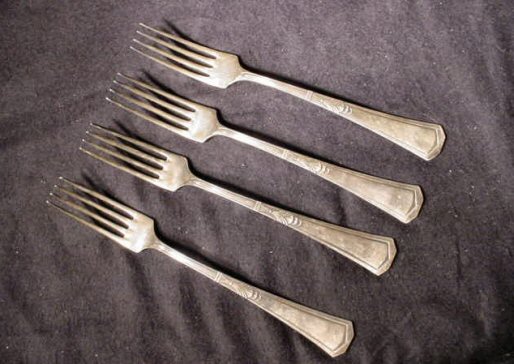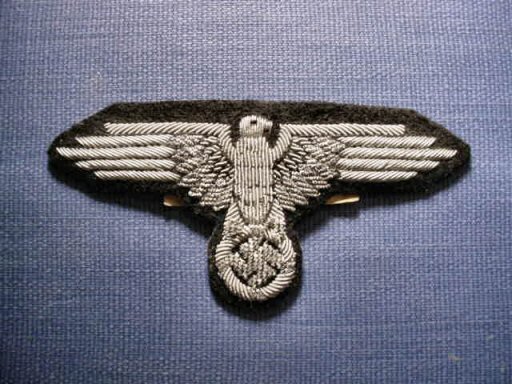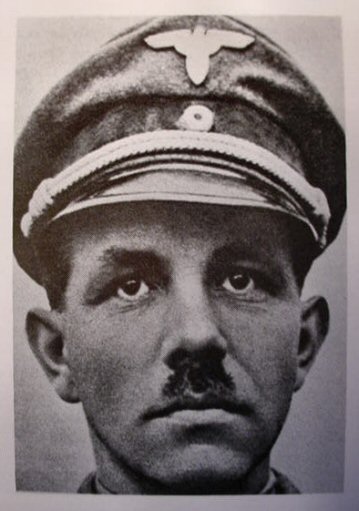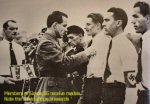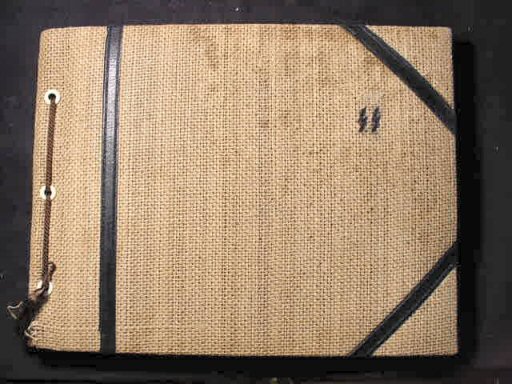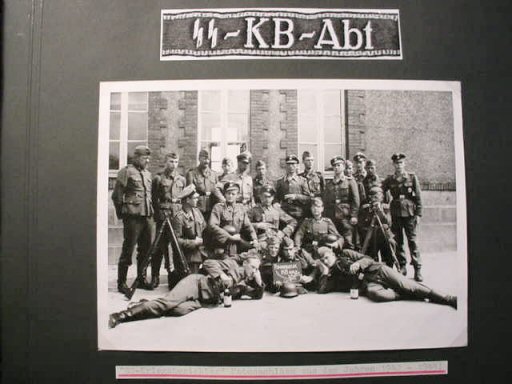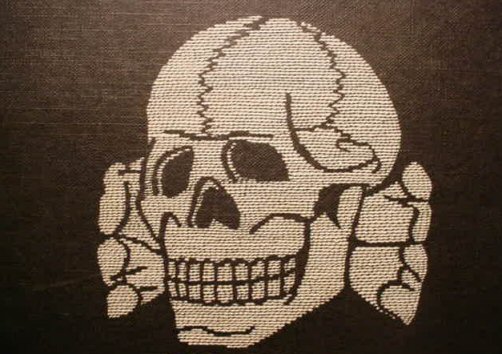|
|
|
|
|
Page 5
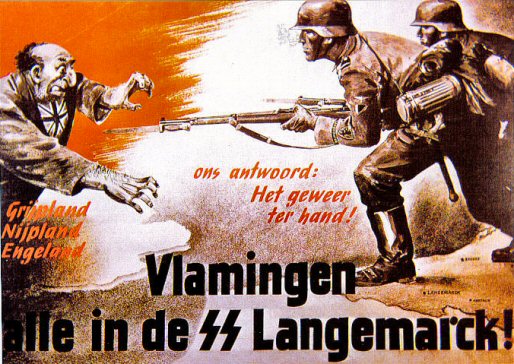 This is a poster for recruitment for the SS volunteer Stormbrigade Langemarck comprising of elite soldiers of Flemish background-- one of the many units of European Waffen-SS fighting alongside the Germans on all fronts. We do not have this poster for sale. It is placed here only for your viewing. |
|
||||||
|
Waffen-SS Sleeve Band Der Führer (Item WAF 5-2) |
||||||
| DESCRIPTION: This is an absolute mint 100-percent-original Bevo sleeve band for officers of the Der Führer Regiment, which was one of the 38 divisions fielded by the immortal Waffen-SS during World War II. For the 1939 invasion of Poland three SS regiments--Deutschland, Germania, and Der Führer--were grouped into a division: the SS-Verfugungstruppe (Special Purpose Troops). Essentially, Der Führer Regiment was an Austrian unit formed in 1938 and fought valiantly through the war as a component of Das Reich Division. It was the 4th SS Panzer Grenadier Regiment. Its last commander was none other that the famed Otto Weidinger, the Knight’s Cross holder and author of the book Comrades to the End. It was among the most successful and decorated units of the Waffen-SS. The Das Reich Division has always since the end of the war been accused of a heinous war crime at Oradour-sur-Glane in France. For an explanation of this event perceived in its true light go to “Events at Oradour-sur-Glane Timeline” on the Google search engine. Also go to “Oradour-sur-Glane Photos” of Adolf Diekmann, Sylvester Stadler. Der Führer Regiment fought the heroic struggle in Russia and was almost completely destroyed, but taking multitudes of the red rats with them. Later redeployed, they fought like tigers in Normandy and finally in Austria at the end of the war as one of the last fully battle-ready units of the Waffen-SS. The band as we have stated is in mint condition woven in black rayon thread with the lettering woven in aluminum wire with the usual salt and pepper backing. This one even has the paper ‘RZM’ series tag with No. 406717 (see images). This item I’m sure would bring much more than we are asking on specialty pages.
PRICE: SOLD |
|
|||||||
|
Original SS Mountain Troop Edelweiss Patch (Item WAF 5-3) |
|||||||
| DESCRIPTION: This is the black-background edelweiss (mountain flower) patch for the M-43 Waffen-SS Gebirgstruppen. With the adoption of the Bergmütze for members of the SS Mountain Troops in October 1943, an SS mountain edelweiss insignia was introduced at the same time and was black in the background to distinguish it from other mountain troops of the army and from other troops of the W-SS. Members of the Waffen Gebirgs Division Handschar (Kroat) Nr. 1 Freiwilligen were also authorized to wear this edelweiss when wearing the M-43, instead of the distinctive fez.
PRICE: $335.00; this patch is 100 percent genuine and has been duly black-light tested (Ultra Rare) |
|
||||||||
|
Fork from the Waffen-SS Divison “Wiking” (Item WAF 5-4) |
||||||||
| DESCRIPTION: The piece of Besteck is from the field headquarters of the SS Division Wiking. This was an elite motorized division recruited from the best of foreign volunteers. During the course of the war, the division progressed from a motorized infantry division to a full-fledged Panzer division. It saw action on the Eastern Front during the Russian campaign with a combat reputation second only to Das Reich Div.. The Wiking is certainly one of the most famous and illustrious Waffen-SS divisions. They fought nobly in Russia, Hungary, and Austria. They were made up of Dutch, Flemish, Norwegian, Danish, Swiss, Finnish, Swedish, Estonian, Walonian, Balkan, and ethnic German volunteers. They were idealists with a strong national feeling towards their own country, but they realized that Europe could only be defended by joint efforts. They remained true to their beliefs and honor until the cities of Berlin and Vienna were destroyed and lay in ruins. These tokens of history, as small as they are, are important as last vestiges of proud, heroic, soldiers like the world had never seen. The forks bear the words: “SS - Div. Wiking.”
PRICE: SOLD |
|
||||
|
Table Knife from the Waffen-SS Divison “Wiking” (Item WAF 5-5) |
||||
| DESCRIPTION: The piece of Besteck is from the field headquarters of the SS Division Wiking. This was an elite motorized division recruited from the best of foreign volunteers. During the course of the war, the division progressed from a motorized infantry division to a full-fledged Panzer division. It saw action on the Eastern Front during the Russian campaign with a combat reputation second only to Das Reich Div.. The Wiking is certainly one of the most famous and illustrious Waffen-SS divisions. They fought nobly in Russia, Hungary, and Austria. They were made up of Dutch, Flemish, Norwegian, Danish, Swiss, Finnish, Swedish, Estonian, Walonian, Balkan, and ethnic German volunteers. They were idealists with a strong national feeling towards their own country, but they realized that Europe could only be defended by joint efforts. They remained true to their beliefs and honor until the cities of Berlin and Vienna were destroyed and lay in ruins. These tokens of history, as small as they are, are important as last vestiges of proud, heroic, soldiers like the world had never seen. The knife bears the words: “SS - Reich.”
PRICE: SOLD |
|
|||||
|
Four Forks from the Canteen of the SS Division Wiking (Item WAF 5-5a) |
|||||
| DESCRIPTION: This fork is from the formal officers’ mess in Heuberg, Germany in 1940-41. It is more formal than the others at Item WAF 5-4 and the table knife at Item WAF 5-5 that is from a Viking command field headquarters. This fork was field mess. Please see our description of the division above at Item WAF 5-5. The fork is finer with a little bit of decorative design unlike the plain field style. It measures about 8 inches long. It also bears manufacturer’s markings as well as the stamped ‘SS Div. Wiking.’ It is a bit tarnished, but will clean up nicely.
PRICE: SOLD |
|
||||||
|
Officer’s Second-Pattern SS Sleeve Eagle (flat wire) (Item WAF 5-6) |
||||||
| DESCRIPTION: This is the ultimate SS officer’s sleeve eagle, which was woven in the flat aluminum thread that is so desired by SS collectors. Because of manufacturers’ variations there were several different styles of machine-woven SS sleeve eagles as is shown in LTC (Retired) John R. Angolias’ book, Cloth Insignia of the SS. The eagle is embroidered on a black wool backing. Some have distinctly embroidered swastikas while others have swastikas, which seem to fill the entire wreath below the eagle, and the eagle’s head on some are not distinct, but are fuzzy and unclear. The wing feathers are not at all clear on some examples. Here we have the finest example yet, and it is the hand-embroidered type with vividly detailed head, swastika, and feathers. An example close to this one, but not quite as good, is shown on page 444 of the aforementioned book. This is the finest one we have ever encountered; crisp, stiff, and perfect. It also is so ‘minty’ that the ‘RZM’ SS label is still 100-percent intact glued to the back. It would be nigh onto impossible to find a better one anywhere.
PRICE: SOLD |
|
|||||
|
Waffen-SS Medal Ribbon Bar (reconstructed) (Item WAF 5-7) |
|||||
| DESCRIPTION: Here is a magnificent ribbon bar containing seven awards to include the Iron Cross Second Class with 1939 clasp, the 1914 Service Ribbon with swords, the SS Long-Service Ribbon with device, the Sudentenland Medal with Prague bar, the three other foreign ribbon are unknown to me, but we know that SS men served in and were honored by several European countries. This bar has al original ribbon and devices, but it has been reconstructed professionally by a German gentleman who had access to these items left after the war. An armchair x-spurt on one of these reprehensible forums did cast aspersion on the pieces because he was just abysmally ignorant enough to not understand what ‘reconstructed’ means.
PRICE: SOLD |
|
|||||||||||
|
Slovakian Volksdeutsche Eagle Cap Badge (Item WAF 5-8; AXIS 4-12) |
|||||||||||
| DESCRIPTION: There were of course the Hlinka Guard, faithful adherents to the National Socialist ideals and among these stalwarts were the elite storm troops or P.O.H.G., a specially selected unit of the fittest and most dedicated young guardsmen formed in May 1941, and sent to Germany for instruction by the SS. Rather more devoted to the cause of Adolf Hitler and the struggle against Bolshevism were those citizens of Slovakia who were of German ethnic stock (Volksdeutscher). Most of the citizens of Slovakia (128,345) were registered as Germans. Besides forming a labor service know as Deutscher aufbau dienst and German Youth Organization called Deutsche Jugend, both under the (DP) Deutsche Partei. The DP’s equivalent of the German Allgemeine-SS was the Freiwillige Shutzstaffel, Volunteer Defense Squad or FS. Its uniform was virtually the same as its German counterpart except that the SS eagle held in its claws; not a wreathed swastika, but a shield with a swastika on it similar to the DP lapel pin. It’s interesting to note the evolution of the badge. Originally, the eagle was of a nonpolitical sort (unlike the SS, German Army, or NSDAP types) and held in its claws a shield with the Slovak emblem. Later, the eagle became the SS type, but still the shield was Slovak. Finally, with all pretense dropped, the SS eagle held in its claws the badge with a swastika on a shield. Just as the Allgemeine-SS in Germany developed within its ranks an action troop. The Verfugungstruppen the forerunner of the Waffen-SS, so the FS burgeoned its own active corps, the Einsatztruppen or ET, which was armed, trained, and provided with uniforms by the German SS in the Ostmark (Austria) in March 1940. The FS numbered 5,622 spread through 126 different units in the country by 1942. This number had risen to 7,500 with its own flying, motorized, and cavalry subunits. They played roles in various operations such as the campaign in Poland and in forming effective antipartisan formations. They fought heroically on the Eastern Front sustained great losses both in infantry and air-force personnel. To understand the way these insignia came to us you need to read “About Our Rings”. After reading this you will realize that German jewelers designed not only rings and other jewelry for the NSDAP, the army, the SS, but also insignia such as Hitler Youth eagles, articles for the Deutsche Ahnenerbe the Reichsführer-SS, etc. And among all these certainly the most rare would be this Slovakian Volksdeutsche Eagle Cap Badge.This is a collector’s gem!
PRICE: $1,450.00 |
|
|||||||||||||||||||||||||||||
|
Photo Album from a Kriegsberichter (War Reporter) (Item WAF 5-10) |
|||||||||||||||||||||||||||||
| DESCRIPTION: This was bought from the family and was the wartime album of SS-Hauptscharführer Paul Augusten, who was a war reporter in the Waffen-SS. He received the Iron Cross Second Class, the Infantry Close-Combat Badge, and the Wound Badge in black. He gave up his life in March of 1943, in Russia by Charkow. He was 26 years old. The album was assembled by a brother from pictures having belonged to Paul. There are 65 great pictures in various sizes; from 9 x 6 1/2 inches to small 3 1/2 x 2 1/2 inches with several 6 x 4-inch photos. There are tremendous images from the Russian front of these daring photographers and reporters at work in harms way. This can be perceived by the many pictures of hero’s graves at the front that you will see in the album. There are some fantastic uniform photos within. There is a 7 x 5 1/2 picture of young amputees in the back with the words: “Kein Kommentar!,” “no comment,” typed under it. I can understand this comment. The war was ugly, the war was cruel, especially on the eastern front, but these young heroes fought it well and saved Europe from what surely would have been a total Bolshevik takeover. One million Waffen-SS men with their Wehrmacht comrades turned the tide and then were classified as criminals at Nuremberg and other infamous witch-hunt trials. This is one of the finest Waffen-SS albums we have ever seen. It measures 12 by 9 inches and is in great shape with typical burlap-style covers.
< PRICE: SOLD |
|
||||
|
Three Forks and Three Spoons from the SS Reich Division (Item WAF 5-11) |
||||
| DESCRIPTION: Here are three field-use spoons and three forks of the type used on the front. The material is marked Rostfrei, which usually means stainless steel. The spoons are marked ‘Nica Rostfrei’ and the forks’ESM Rostfrei.’ Both spoons and forks have ‘SS Reich’ stamped on their tangs. They are quite plain with almost no décor except for a few simple scrolls. The SS-Reich Division originated in 1939. This outfit was known as Panzerverband Ostpreussen/Panzer Div. Kampf. Then in October 1939, they were considered the SS-Verfungsdivisoin. In April 1940, they were the SS-Division Deutschland and then in October 1940, they became the SS-Division “Reich”, and in May 1942, they finally became known as Das Reich. It fought bravely in the Netherlands, France, the Balkans, Russia, Normandy, Ardennes, Hungary, and Bohemia. It surrendered to the Americans in May 1945.
PRICE: Sold |
|
||||||||
|
Skull Ring (Item WAF 5-12; WEHR 19-12) |
||||||||
| DESCRIPTION: This is a ring that may well be a “West Wall ring.” This style, among other motifs, was commonly worn by soldiers of the West Wall (Siegfried Line). The angle of the skull, unlike so many skull-decorated rings of the German services, looks to the left when viewed. This is why we feel that it might be the style for the Waffen-SS. Note in our pictures that the SS skulls of the second type look to the left and are very definitely not looking straight at you. The floral design at the sides is usual on West Wall rings. The ring probably was not exclusive for the SS, but there is a probability that because of its design it may well have been favored by them. This is a good-looking elite-forces ring, in any case.
PRICE: SOLD |
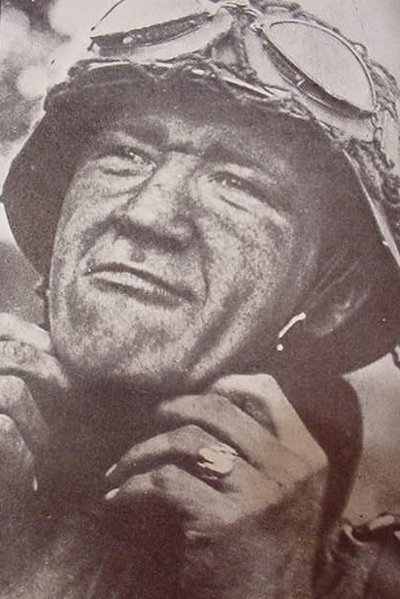 |
German soldiers of the Army and the Waffen SS wore many styles of skull
rings as a symbol of their elite KORPGEIST." This Landser, who resembles
John Wayne, is seen wearing a large Totenkopf ring. |
Page Five |
 |
Please refer to item designator in parentheses in all correspondence.
Please E-mail for any additional information you may need.If you prefer, contact 'Germania' at PO Box 68, Lakemont, GA 30552
or call at 706.782.1668.
Please! do not call during the wee hours of the morning. The best time for calling us is between 10 and 11 am and between 9 and 11 pm eastern time.








